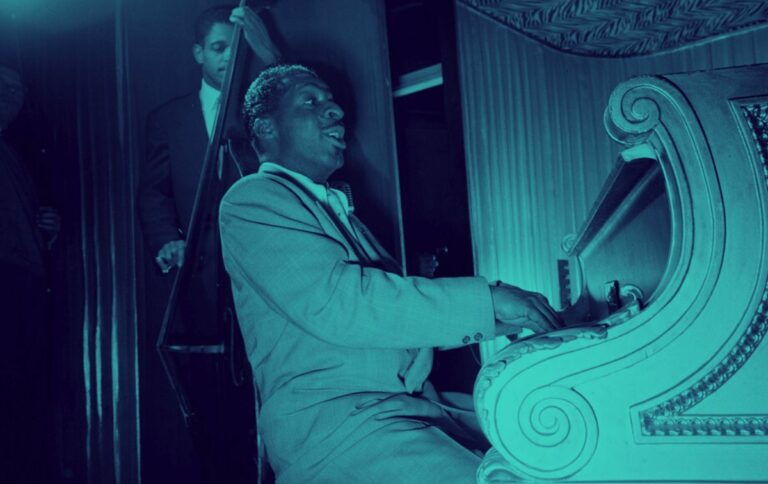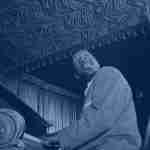Jazz chords are at the very heart of why jazz sounds the way it does and as a player, these sounds are essential to have in your ear on a deep level. But what makes this so difficult? What are jazz chords and why do they sound different than regular chords? And what makes them so much more difficult to hear and identify?
If you want to learn how to hear, play, and understand jazz chords on a deep level, you’re in the right place.
To play jazz, you have to know chords inside & out. There’s no way around it.
So while some of this might seem like review to more seasoned players, there’s still plenty of opportunity today to fill in any of the gaps in your understanding.
Perhaps you’ll have an aha moment that helps you get to the next level, or maybe a subtle piece of information from today will cause something to suddenly click that previously didn’t.
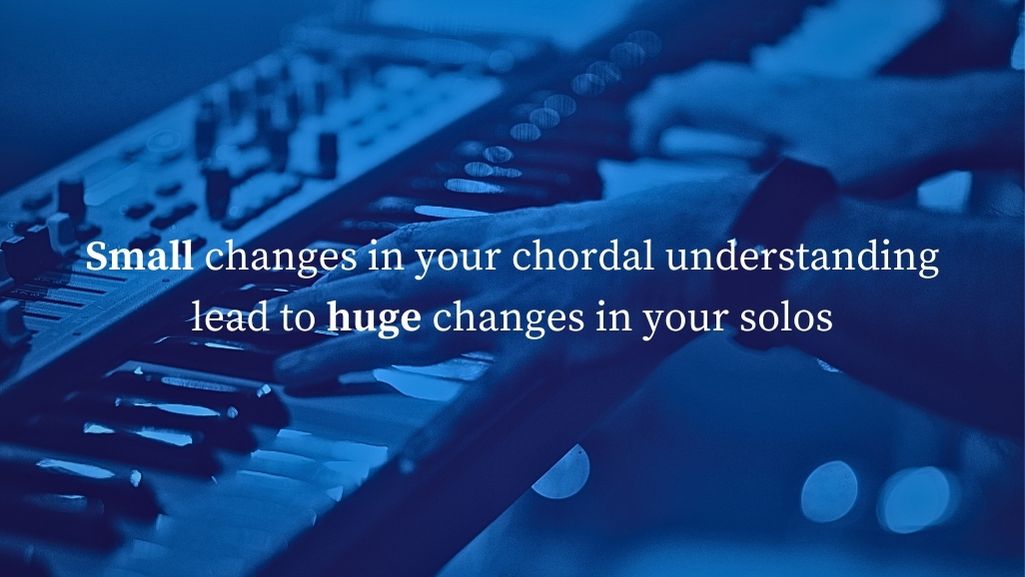
The important thing is to go slowly, let the information sink in, and allow your brain to make the necessary connections.
In time, jazz chords will all make sense to you…here’s the plan for today…
- Prerequisites – We’ll start with the prerequisites to jazz chords, helping you get a fundamental understanding of the basic musical concepts that make up the structures used in jazz
- Differences – Then we’ll talk about what makes jazz chords different from so-called “normal” chords because this is central to your understanding.
- Hearing – Next we’ll quickly talk about how you can easily learn to hear and identify jazz chords. It’s actually simpler than you might have thought.
- Basic Jazz Chords – After that we’ll break down all the basic jazz chords you need to know. We’ll talk about the symbols, the construction, the formulas, the sound and voicings, and more.
- Advanced Jazz Chords – And finally, we’ll touch on the more advanced chords used in jazz and point you in the right direction to study these more complex chords.
So buckle up and get ready to explore your Definitive Guide to Jazz Chords…
Prerequisites to jazz chords
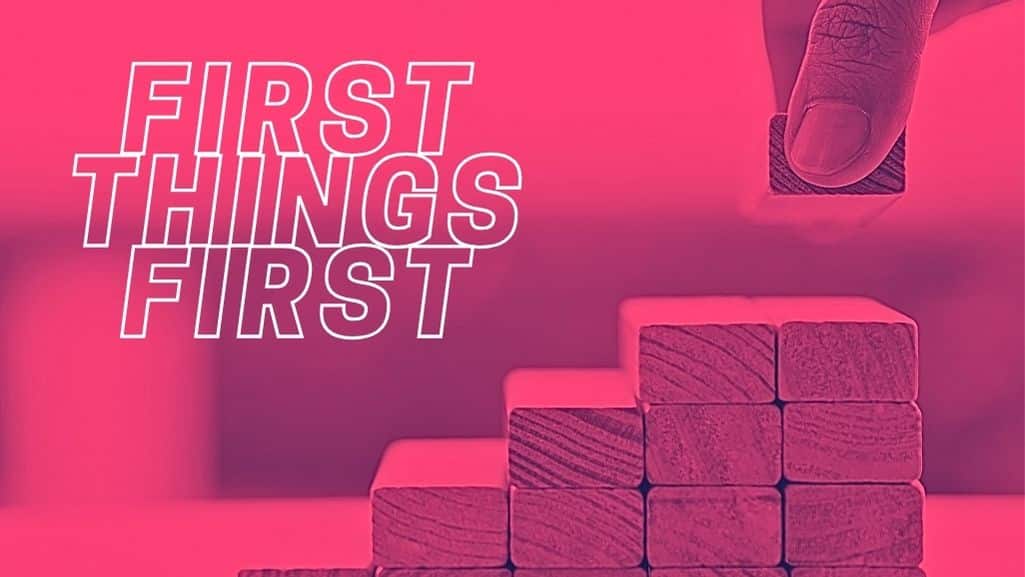
Before we get to all the fancy jazz chords, it’s necessary to know the basic structures of what chords are made up of…
Intervals
The most basic musical structure is The Interval – the space between two notes. An interval can be major, minor, perfect, augmented, or diminished.
Here are all the intervals and their names. Have a listen to them and pay attention to how each interval sounds…
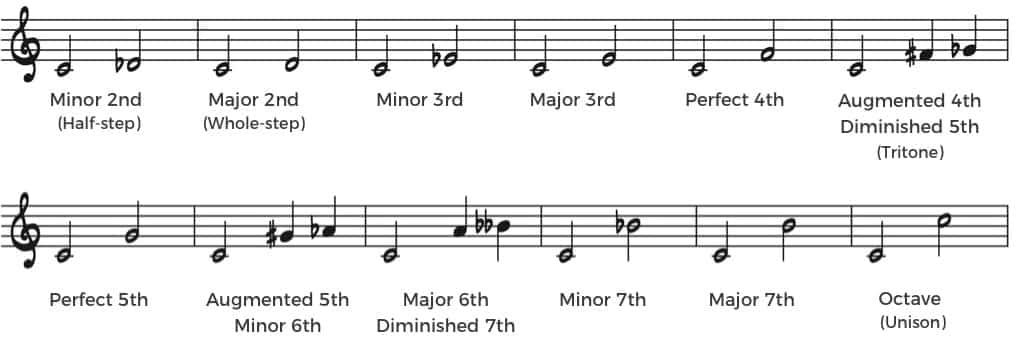
And notice that a few of them can be called by several names depending upon how they’re spelled…
For instance, the space of a tritone which is the space of 6 half steps, or 3 whole steps (hence the name “tritone,” meaning 3 tones) is called an augmented 4th when it’s spelled C to F#, but a diminished 5th when it’s spelled C to Gb, but they sound the same…

Or another tricky one that most people never think of is a major 6th (C to A) and a diminished 7th (C to Bbb).

To your ear, these will sound identical because Bbb is the same pitch as A, but the different spellings imply a different context.
Now, In jazz, we’re often a little looser with these namings and occasionally spell things so they’re easier to read, rather than strictly adhering to what’s technically correct.
For example, when we get to diminished chords later and the diminished scale, sometimes we’ll show the Bbb as A because it’s 10 times easier to see and read.
But remember, just because we might bend the notation rules once in a while doesn’t mean they don’t exist for a reason, so it’s a good idea to know the differences between each interval, even if they sound the same.
Triads
After intervals, triads are the next basic unit to understand before we get to the essential jazz chords.
Triads are a three note chord, the most basic chord possible. (Anything with less than three notes is technically just an interval)
There are 4 primary triads:
- Major
- Minor
- Diminished
- Augmented
And the best way to understand them is to break them down into the intervals that make up each structure.
So for example, when you put a major 3rd and a perfect 5th together, you get a Major Triad…

When you put a minor 3rd and perfect 5th together, you get a Minor Triad…

When you put a minor 3rd with a diminished 5th, you get a Diminished Triad…

And finally, when you pair a major 3rd with an augmented 5th, you get an Augmented Triad…

7th chords
After intervals and triads, the next prerequisite musical structure to know is the 7th chord, and instead of three notes like a triad, it adds a fourth note.
This fourth note is the interval of a 7th, which can be major, minor, or diminished…
So for instance, a Major 7 chord includes not just the basic major triad with the intervals of a major 3rd and perfect 5th, but also the interval of a major 7th…

Now a chord with a major third and a minor 7th is called a Dominant chord (In classical music they often call it a major minor 7 chord).

Next we’ll lower the 3rd, giving us a minor 3rd and a minor 7th, creating a Minor 7 chord…

Then we’ll flat the 5th, creating a diminished 5th in the structure, which gives you a Half Diminished 7 chord.

And finally, lowering the 7th from a minor 7th to a diminished 7th, gives you a fully Diminished 7 chord.

So now that you have a refresher on the prerequisites of intervals, triads, and 7th chords, we’ll talk a little bit about what makes chords in jazz different and how you can learn to hear them.
How can you learn to easily hear & identify chords in jazz?

Jazz chords are a little different because rather than simple root position chords (1-3-5-7), they instead can use any of the notes from the whole structure up to the 13th and mix up the notes…
We call this a Chord Voicing.
So to voice a C major 7 chord, instead of 1-3-5-7, you might play 7-9-3-5 over the bass note…have a listen to the 7-9-3-5 voicing…
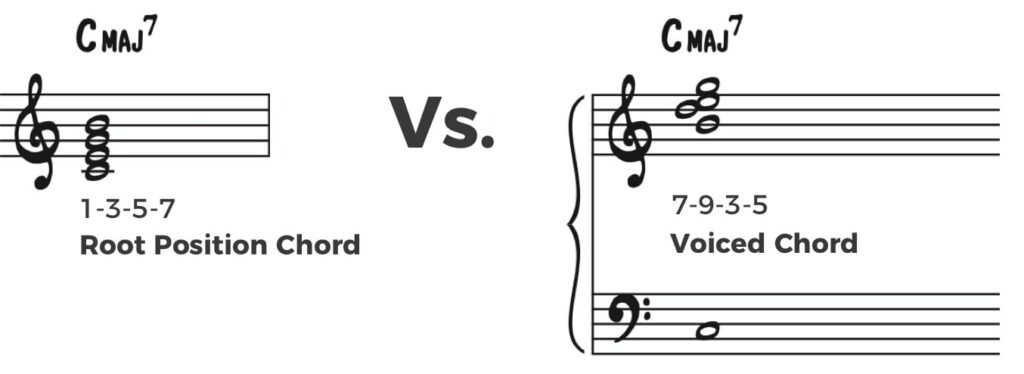
That means in jazz, the symbol “C Maj7” may include not only 1-3-5-7 but also 9-11-13, or even some sort of alteration like a #11, and the notes don’t need to be played in order as in 1-3-5-7, they can be mixed up like the previous chord voicing.
So with all these added upper structure notes and playing them out of order, how can you still hear and identify the chord quality?
Well, it’s actually not as tricky as it sounds. The key is to have the crucial information at your disposal for each chord.
You have to know:
- The basic construction of the chord – You want to have a firm grasp on the lower structure of the chord, 1-3-5-7, and all the intervals that make up the foundation of the chord
- The upper structure of the chord – In jazz, you have to know the upper structure (9-11-13) of every chord you encounter as well, which is why we’ll detail these chord tones throughout this lesson
- The essential sound of the chord – The easiest way to learn to hear jazz chords is to focus on simple two note voicings and common chord voicings that build on these sounds, so for each chord we’ll share these with you.
When you know these 3 key pieces of information, jazz chords become clear, which is why when we go over all the basic jazz chords to know right now, we’ll highlight all of these things for you…
Basic Jazz Chords to know
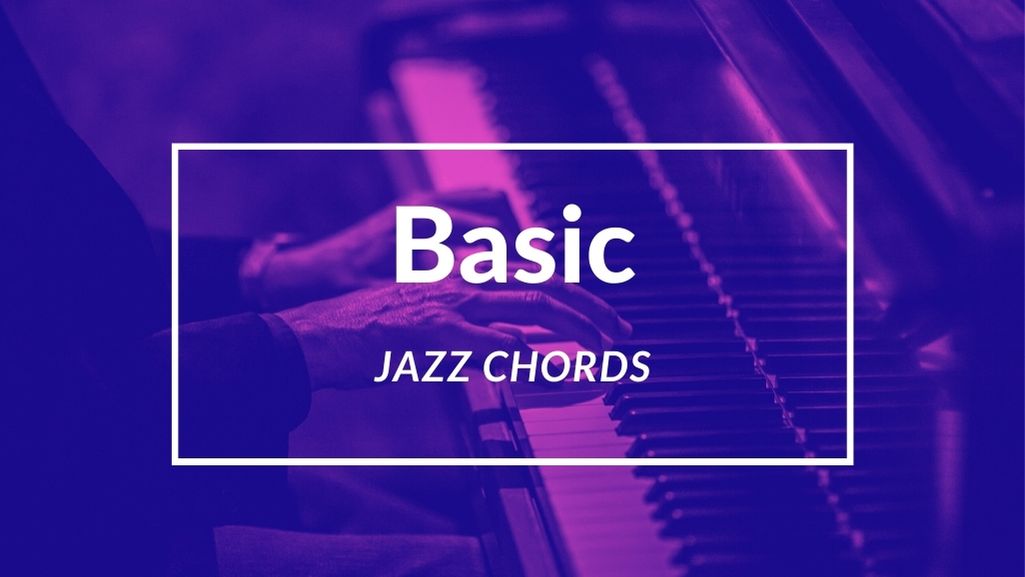
When you’re learning how to play jazz, it can seem like there are a million chords to know. But the truth is, all of these chords can be boiled down to just a few essential jazz chords to know…
The Basic Jazz Chords that you have to know inside and out are:
- Major 7 Chords
- Dominant 7 Chords
- Minor 7 Chords
- Half Diminished Chords (Minor 7b5)
- Diminished Chords
And we already went through these chord qualities as simple root position 7th chords, but now we’ll dig deeper into the actual contexts that you find them within jazz.
By thoroughly understanding the basic construction, upper structure, and sound of each chord, you’ll quickly become comfortable with all the basic jazz chords.
Major 7 Jazz Chords

The first and most important jazz chord to know is the Major 7 chord. And the reason it’s so important is because it forms the foundation for understanding every other chord.
For example, as you probably know, a dominant 7 chord is simply a major 7 chord with a b7…

And all the chords we’re going to look at are like this…they all build on the chord that came before it.

So, major 7 chords being the starting point makes them the most important, so let’s get into these…
The Symbol
Major 7 chords are most commonly presented with the abbreviation Maj 7 or a triangle.

You may also see a symbol with just the root note like C, but technically this is not a major 7 chord. It’s just a C major triad

And you may encounter a chord with a 6th, or a 6th and a 9th, like C6 or C69, which also contains no major 7.

These two variations are a little confusing because from an improvisation standpoint, the major scale will still sound correct over them, but the actual chord voicings do not usually contain the major 7th chord tone which can change the sound, mood, and even the function of the chord.
Keep in mind though, when it comes to the 6th (or the 13th, which is the same note) over a C Major 7 chord, the pianist may include the 6th/13th within the voicing, or even sub out the major 7 for the 13th/6th if they feel so inclined.
The Formula & Construction
To construct a Major 7 chord, you use all of the natural notes available, 1-3-5-7 for the lower structure and 9-11-13 for the upper structure. And when these notes are reordered into a scale, they form a Major Scale, or the Ionian Mode.

The Sound & Voicings
To hear the essentials of a major chord, first learn to hear a simple two note voicing that includes the two essentials for this chord, the major 3rd and the major 7th.
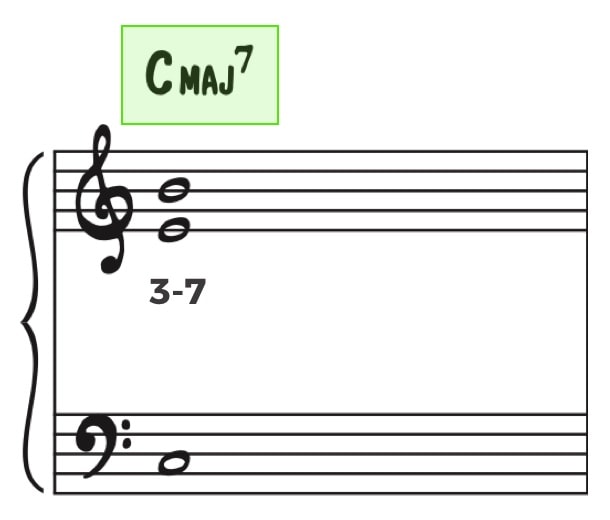
And then, we’ll switch the order of the two note voicing by placing the 3rd in the next octave, making it 7-3 which is the next two note voicing to learn to hear…
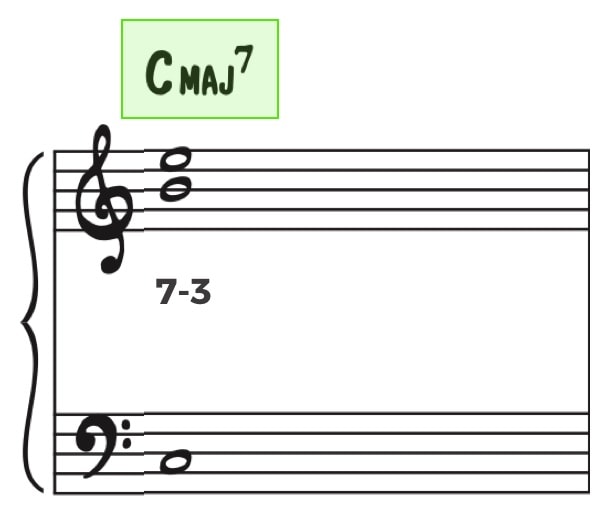
Once you can easily hear those, then you can fill out each of these two note chord voicings, transforming them into two of the most common chord voicings, 3-5-7-9 and 7-9-3-5.

Notice that these more filled out voicings are built upon the two basic two note chord voicings that you already learned to hear.
Also, it’s important to note that the 11th of a major chord is a half step above the 3rd, so if a pianist played the natural 11th in the chord voicing, it would confuse the sound of the major 3rd…
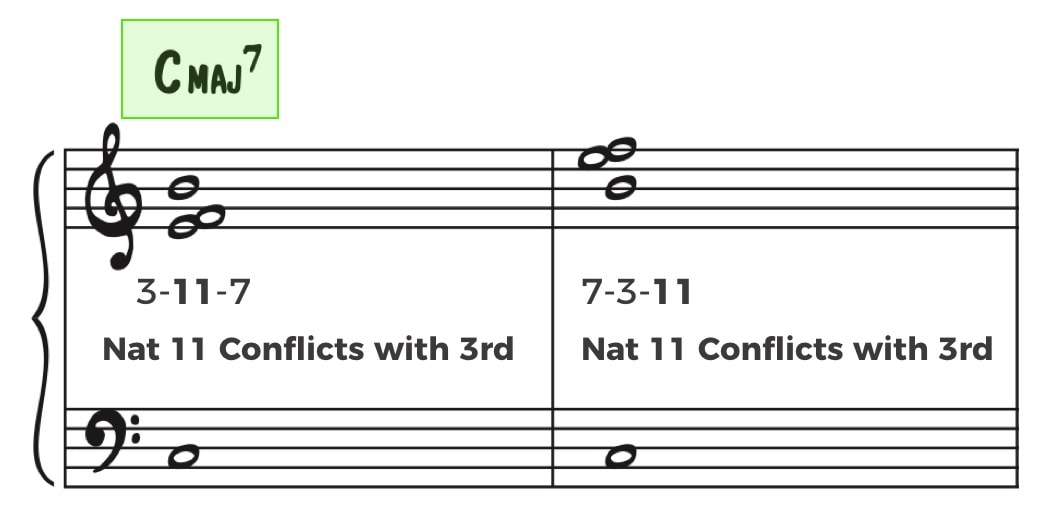
To remedy this, a pianist will often raise the 11th if they choose to add it to the chord voicing, making it a C major 7 #11 chord.

So now you should have a firm understanding of major 7 chord voicings and realize that they may sometimes include the 9th, #11th, or the 13th depending upon how the pianist chooses to voice the chord.
Major jazz chords in context
Now we’re going to share with you some places in real tunes where these chords show up and try to hear them in context.
Keep in mind that it’s often quite difficult to hear exactly what the pianist is playing on classic recordings because the pianist is frequently covered by other members of the group, or the fidelity of the recording is not that good.
It’s not absolutely necessary to hear the exact voicing that’s going on. It’s more important to develop the ability to hear and feel the presence of the chord quality.
Developing your ear is so important in jazz, so if you want some extra help with this skill, have a look at our course The Ear Training Method

Okay, so to hear major 7 chords in context, first listen to Wynton Kelly play On Green Dolphin Street and try to hear the presence of a major chord
The first chord after the intro is an Eb major 7 chord that you can hear clearly if you pay attention…

And next, listen to the beginning of Dexter Gordon playing Four, and try to hear the presence of the major chord…
The tune starts with an Eb major chord…

Lessons to Master Major Chords
Check out these lessons to further your understanding of major chords:
- 5 Mistakes You’re Making With Major Chords (Premium)
- Mastering Essential Chord Progressions: Major to Minor (Premium)
- Miles Davis: The Power of the Triad
Dominant 7 Jazz Chords

Now that you’ve learned all about major 7 chords, we’ll move onto dominant 7 chords…To arrive at a Dominant 7 chord from a Major 7 chord, you simply flat the 7th like we talked about before.
And Dominant 7 chords are everywhere and one of the most important sounds in jazz, so make sure you get comfortable with them…
The Symbol
The symbol for a dominant chord is generally just the root note with the number 7.

Also, a confusing point with dominant chord symbols is that some charts may show you a chord of the root note with the 9th or 13th…
But these are actually just dominant chords (C7) that include a natural 9th or 13th in the voicing.

So remember that even though these symbols don’t necessarily look like a dominant chord, they actually are.
The Formula & Construction
To construct a Dominant 7 chord, you take the Major 7 structure and simply flat the 7th making it 1-3-5-b7 for the lower structure and 9-11-13 for the upper structure.
When these notes are reordered into a scale, they form the Mixolydian Mode.

The Sound & Voicings
To hear the essentials of a dominant chord, take a listen to this two note voicing that includes the major 3rd and the minor 7th, which together create a dominant 7 chord.
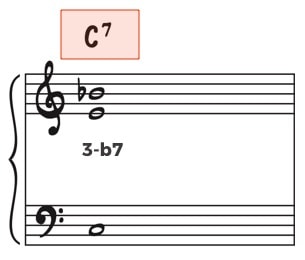
Next, like we did before with major 7, we’ll switch the order of the two note voicing by placing the 3rd in the next octave, making the two note voicing b7-3…
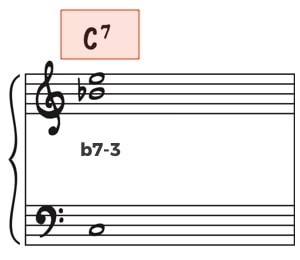
And finally we’ll fill out each of these two note chord voicings, transforming them into two of the most common chord voicings, 3-5-b7-9 and b7-9-3-5.

As with major 7, notice that the filled out voicings are built upon the two basic two note chord voicings that you already learned to hear, which makes them very important to learn.
And again, take note of the natural 11th within dominant chords and that it’s a half step away from the 3rd.
Like major 7 chords, a pianist will raise the 11th if they choose to add it to the chord voicing, making it a C7 #11 chord.

Dominant jazz chords in context
To hear dominant chords in context, have a listen to Miles Davis playing If I Were a Bell and try to hear the presence of a dominant chord
The first chord is a G7 chord and you can hear the C7 in the second bar…

And next, listen to Sonny Stitt and Bennie Green playing The Blues and you’ll easily hear the use of dominant chords…
In a Blues, all the first 4 chords are dominant chords…

Lessons to Master Dominant Chords
Check out these lessons to further your understanding of dominant chords:
- 10 Easy Options For Expanding Your Dominant 7th Vocabulary
- Essential Progressions – 4 Sonny Rollins Tools to Tackle The V7 of V7
- How to Play V7 to I like a Pro: 5 Techniques from the Masters
Minor 7 Jazz Chords

The Symbol
The symbol for a minor 7 chord is usually a dash with a 7, or the letters min with a 7…

One very important thing about minor chords is that they don’t all function the same way and that the chord symbol does not always help you understand how the chord is functioning.
Chord function is one of the many misunderstood things that we dive into in extreme detail in our course Jazz Theory Unlocked

So if you’re really curious about understanding chords, harmony, and chord function on a deep level, check out the course because it will significantly speed up your progress…
Now, one symbol that you may see for a minor chord will include the 6th or the 13th and this alters the sound of the minor chord quite a bit.
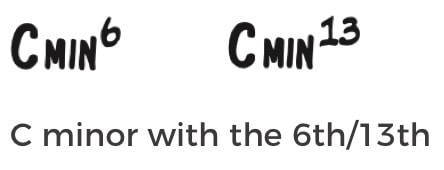
This C minor 6th or 13th chord is a little different from a C minor 7 chord, and it usually functions as a tonic minor chord, so watch out for this different sound…
The Formula & Construction
To construct a Minor 7 chord coming from the Major 7 structure, you flat the 3rd and the 7th making it 1-b3-5-b7 for the lower structure and 9-11-13 for the upper structure.
When these notes are reordered into a scale, they form the Dorian Mode.

The Sound & Voicings
To hear the essentials of a minor chord, check out this two note voicing that includes the minor 3rd and the minor 7th, which create the minor 7 chord sound.
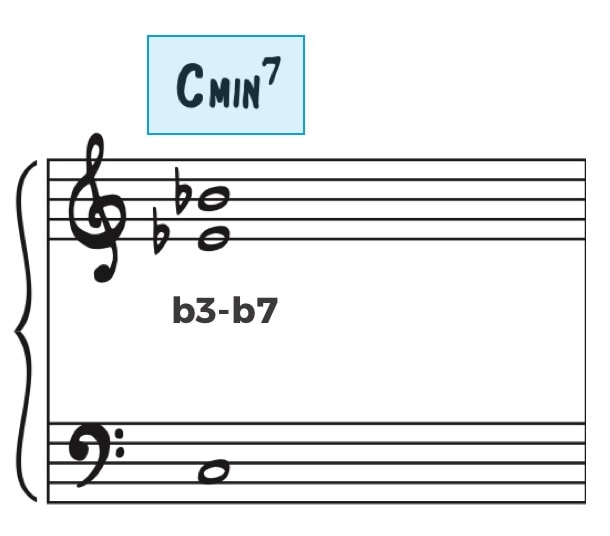
Then we’ll switch the order of the two note voicing by placing the 3rd in the next octave, making the two note voicing b7-b3…
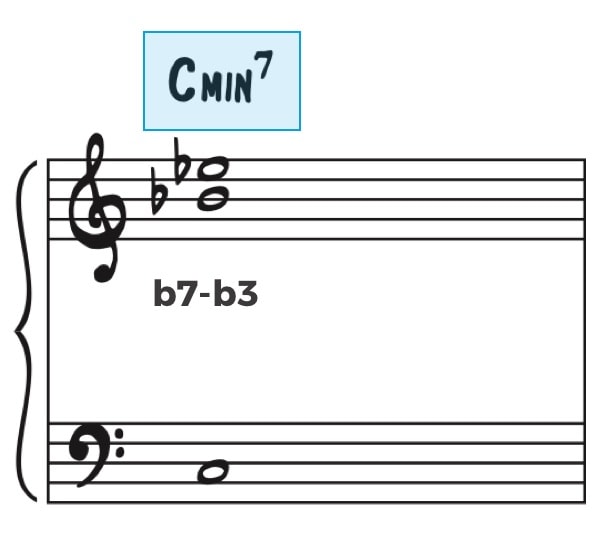
And finally, as before we’ll fill out each of these two note chord voicings, giving us two of the most common chord voicings, b3-5-b7-9 and b7-9-b3-5.

Minor jazz chords in context
To hear minor chords in context, let’s go back to On Green Dolphin Street, but this time, listen to the second chord, Eb minor 7…

And then listen to Four again, while focusing on the second chord…

Lessons to Master Minor Chords
Check out these lesson to further your understanding of minor chords:
- The Confusion Around Minor Chords Finally Explained
- 8 Easy Ways to Play Minor Chords Like Clifford Brown
- 3 Roy Hargrove Minor Exercises on What Is This Thing Called Love
Half Diminished 7 Chords, also known as Minor 7b5 Chords

The Symbol
Half diminished chords can be notated several ways because sometimes they aren’t even called half diminished chords. Sometimes people refer to them as minor 7 b5 chords.
So the two common symbols will be a circle with a slash through it and a 7, or some version of a minor 7 chord with a b5…

The Formula & Construction
To construct a Half Diminished 7 chord coming from the Major 7 structure, you flat the 3rd, 5th and 7th for the lower structure making it 1-b3-b5-b7, and you flat the 9th and 13th for the upper structure, b9-11-b13.
When these notes are reordered into a scale, they form the Locrian Mode.

The Sound & Voicings
To hear the essentials of a half diminished chord, we actually have to add a 3rd note to the voicing because a defining characteristic of half diminished chords is the flat 5.
So for this first voicing, it will be a three note voicing: b3-b5-b7
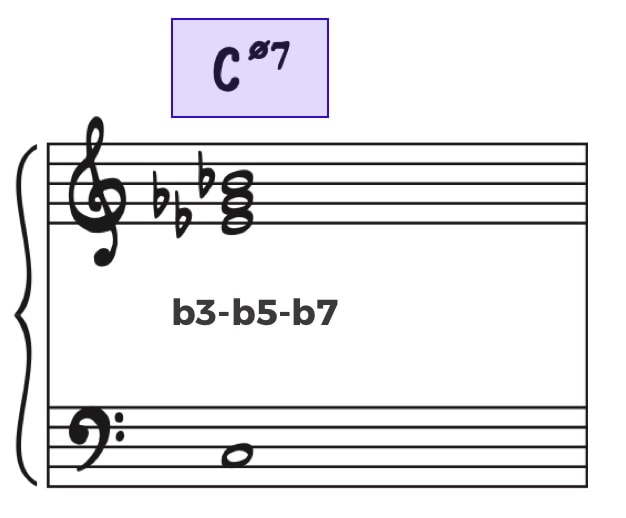
Then we’ll switch the order of the three note voicing and throw the 3rd on top, making it b5-b7-b3
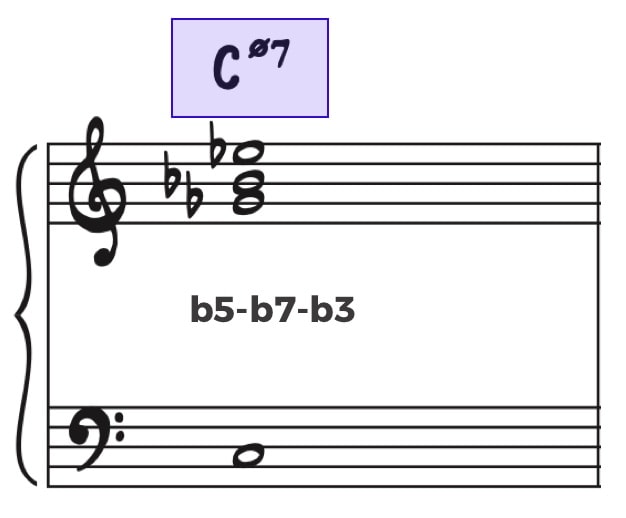
And finally, we’ll fill out each of these three note chord voicings, however because of the dissonance of the b9 with the root of the chord, we’ll actually include the root of the chord in the voicing instead of the b9, which is very common.

Now, instead of the root, another option would be to raise the b9 to a natural 9, but it does change the sound of the voicing quite a bit as you can hear below (We’ll take the voicing up an octave so it’s easier to hear)…

Half Diminished jazz chords in context
To hear half diminished chords in context, have a listen to Dexter Gordon on Blue Bossa (For more about this solo, check out this lesson)
The Half Diminished chord happens right here…

And next, listen to Bird and Diz on Hot House (To dig into this tune more, go to this lesson)…
This tune starts with a half diminished chord…

Lessons to Master Half Diminished Chords
Check out these lessons to further your understanding of half diminished chords:
- How To Not Suck At Half-Diminished Chords
- Why You Still Suck At Half Diminished Chords (Premium)
- Techniques to Master the Minor ii V Progression
Diminished 7 Jazz Chords

Okay, next we’ll flat the 7th again, making it a Bbb (read B double flat), but we’ll notate it as A to keep things a little simpler…and we’ll get into diminished chords…
The Symbol
Generally, diminished chords are notated with a circle and the number 7, or the abbreviation dim with a 7…

The Formula & Construction
A diminished chord is constructed by stacking minor thirds (C-Eb-Gb-Bbb)…so the lower structure will just keep repeating because a minor 3rd up from Bbb is C…
So it does not necessarily have an upper structure if you think of it like this.
But if you think about the chord in terms of the Diminished Scale, which is what we’re doing today, you can call the other 4 notes within the scale the upper structure of the chord…

Is this correct?
Well, like I’ll mention in the voicings section, typically you don’t remove chords completely from how they’re functioning, but when you remove diminished chords from any sort of function, then the structure that makes the most sense to draw from is the Diminished Scale.
So, that’s how we’ll look at it for today.
The Sound & Voicings
Rather than expanding simple voicings for a diminished chord, we’ll just look at two different common voicings.
To hear the essentials of a diminished chord, we’ll use a three note voicing that includes the minor 3rd, the diminished 5th, and the diminished 7th, which we’ll notate here as A to more easily see how it relates to the Diminished Scale.
And, it may seem a little odd, but we’ll notate the chord tones here in relation to the major scale because that’s what we’ve been doing with every other chord quality up to this point, but realize that this is only one perspective…
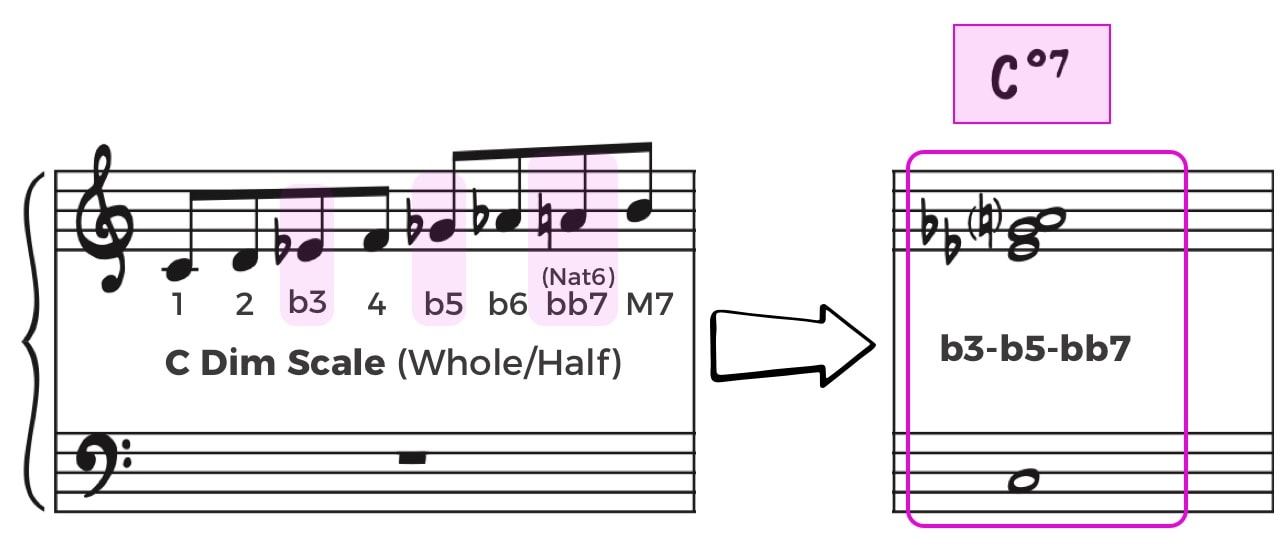
In general, I don’t tend to think about a diminished chord in relation to the major scale like this, and completely separate from chord function, but because we’re talking about single chords in isolation today, this perspective makes sense.
If you want to really understand diminished chords and scales though, I highly suggest checking out our Jazz Theory Unlocked course where we go over all the confusing parts of these structures, explain them in depth, and give you a diminished chord framework for understanding how they actually function in tunes.
Okay next we’ll look at another voicing of a diminished chord that jazz pianists use a lot, and it includes the major 7th within the voicing, which as you can see, comes straight from the Diminished Scale…
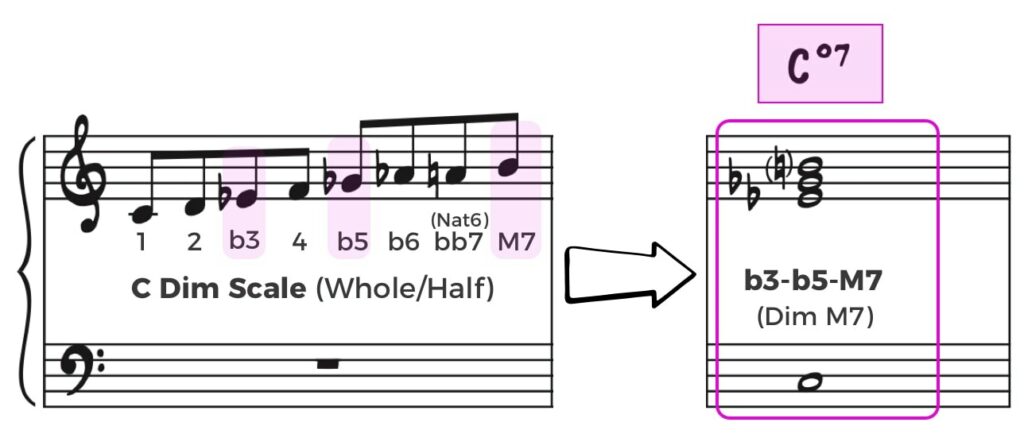
Sometimes, people refer to this as a Diminished Major 7 chord or voicing…
This is only one perspective on what you might call it, and to be honest I don’t typically think like this because I usually think of a diminished chord (or any chord for that matter) within some sort of functional context.
But for our purposes today, this diminished voicing and perspective is certainly beneficial to add to your understanding.
Diminished jazz chords in context
To hear diminished chords in context, take a close listen to Sonny Rollins on St. Thomas…
In the last 4 bars of the form, listen for the F# Diminished chord…

And next, listen to Lester Young on the start of Body and Soul…
When the changes move into the 5th bar, there’s usually a diminished chord…

Lessons to Master Diminished Chords
Check out these lessons to further your understanding of diminished chords:
- 10 Diminished Patterns That Will Transform Your Next Jazz Solo
- The Jazzadvice Diminished Handbook (Premium)
Advanced Jazz Chords to Know
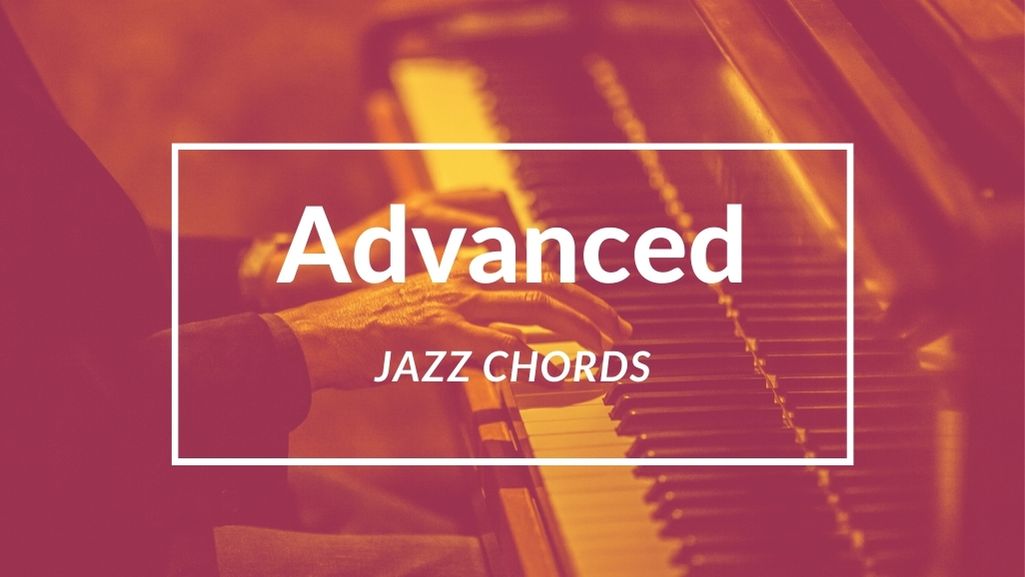
Besides the basic jazz chords to know that we just went over, there are quite a few more complex jazz chords to know. But here’s the thing…
These more advanced chords are simply variations of the basic jazz chords…so if you really master the basic ones, these will be a piece of cake.
Altered Dominant Jazz Chords
Altered dominants refer to a dominant chord that has some sort of an alteration like a b9, #9, or b13 and they’re everywhere in jazz.
Use these lessons to master altered dominant chords:
- Demystifying Dominant 7 Chord Alterations: A Visual Guide
- Keys to the Altered Scale
- 5 Steps to Becoming a Lyrical Master With Altered Dominants
Sus chords and Susb9 Chords
Sus Chords and Susb9 chords (AKA Phrygian Chords) are yet another variation of a dominant 7 chord and they are really tricky for nearly everyone.
Use these lessons to master both Sus and Sus b9 chords…
- Mastering Sus Chords: Adding Options to Your Arsenal
- The Definitive Guide To Phrygian & Sus Flat 9 Chords (Premium)
Lydian Chords
Lydian chords are simply a major chord with a #11, but they’ve become an integral part of the modern jazz sound.
Use these lessons to learn more about lydian chords…
Minor Major Chords
Minor Major chords are just a minor 7 chord with a major 7th instead of a minor 7th…but they’re important to understand.
This chord by itself is not very complex, but understanding how it relates to the Melodic Minor Scale and trying to incorporate all the modes that come along with it is certainly a more difficult feat.
Use these lessons to further your knowledge of minor major chords
Your Journey to Master Jazz Chords
As you found out today, jazz chords are a bit different from “normal” chords and there’s a whole lot more to learn about them than you may have expected.
On your road to master every jazz chord that you may encounter, remember everything we went over today…
We started with reviewing the prerequisites needed to understand jazz chords on a deep level. These included: Intervals, Triads, and Seventh Chords.
We then talked a little about Chord Voicings and what you need to know about each chord to have a firm grasp on it: The lower structure, the upper structure, the symbol, the formula, and the sound and voicings.
Then we got into all the specifics for all 5 fundamental jazz chord types: Major 7, Dominant 7, Minor 7, Half Diminished 7, and Diminished 7.
Understanding, hearing, and playing over jazz chords is by no means an easy feat…but if you dedicate some time to each chord and the details we gave you today, you’re sure to become a chord master in no time.
And if you are serious about taking your chord knowledge to the next level, be sure to check out Jazz Theory Unlocked.

All the little holes in your understanding will certainly hold your playing back and this course is designed to clarify all of these subtle details that pro players take for granted.
With that said, have fun expanding your knowledge of jazz chords and keep studying these sounds and structures because you can never know them too well!
